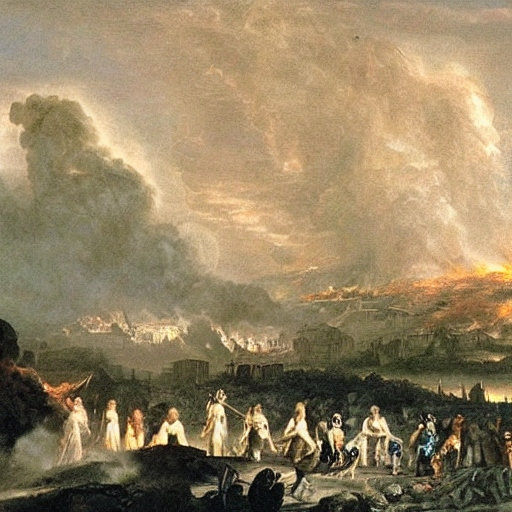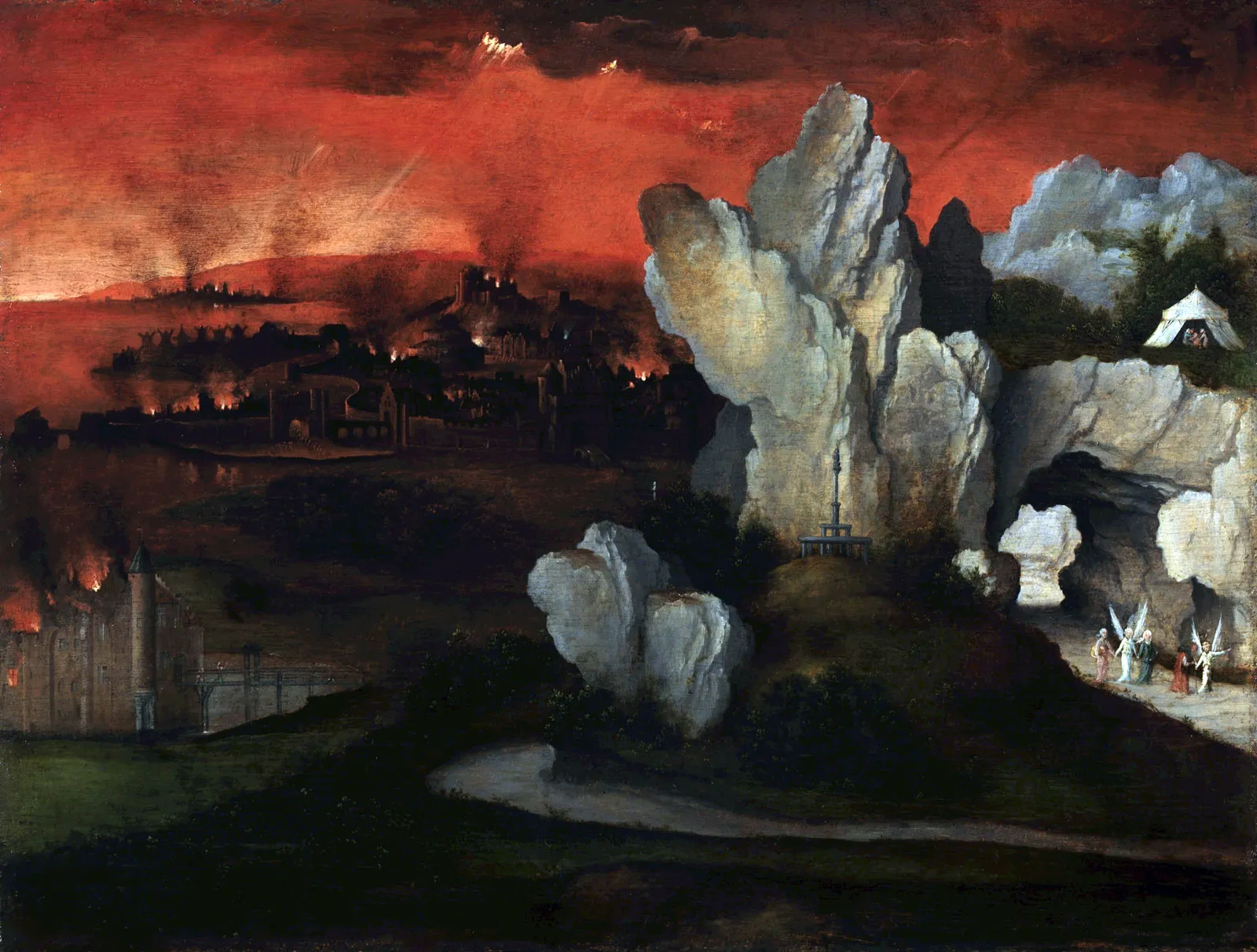Evidence of Sodom and Gomorrah’s destruction by fire and brimstone (sulfur)
Sodom and Gomorrah are two cities mentioned in the Bible, specifically in the Book of Genesis. According to the biblical narrative, these cities, along with three others in the region, were known for their wickedness and immorality.
The story goes that God decided to destroy Sodom and Gomorrah due to their sinful behavior. Two angels, disguised as men, visited Sodom to rescue Abraham’s nephew, Lot, and his family. The men of the city demanded that the visitors be handed over to them for immoral purposes, but Lot offered his daughters instead. The angels warned Lot and instructed him to leave the city with his family, as destruction was imminent.
As they left, fire and brimstone (often associated with sulfur) rained down on Sodom and Gomorrah, destroying the cities and their inhabitants. Lot’s wife, however, disobeyed the angels’ command not to look back and turned into a pillar of salt.
The story of Sodom and Gomorrah is often used as an example of divine judgment and the consequences of wickedness. The exact location of these cities remains uncertain, with several theories proposed over the years, but there is no conclusive archaeological evidence to confirm their existence or the specific details of the destruction described in the Bible.
The ruins of Sodom and Gomorrah have been discovered southeast of the Dead Sea. The modern names are Bab edh-Dhra, thought to be Sodom, and Numeira, thought to be Gomorrah. Both places were destroyed at the same time by an enormous conflagration. The destruction debris was about three feet thick. What brought about this awful calamity? Startling discoveries in the cemetery at Bab edh-Dhra revealed the cause. Archaeologists found that buildings used to bury the dead were burned by a fire that started on the roof.
What would cause every structure in the cemetery to be destroyed in this way? The answer to the mystery is found in the Bible. “Then the Lord rained down burning sulfur on Sodom and Gomorrah—from the Lord out of the heavens” (Genesis 19:24). The only conceivable explanation for this unique discovery in the annals of archaeology is that burning debris fell on the buildings from the air. But how could such a thing happen?
There is ample evidence of subterranean deposits of a petroleum-based substance called bitumen, similar to asphalt, in the region south of the Dead Sea. Such material normally contains a high percentage of sulfur. It has been postulated by geologist Frederick Clapp that pressure from an earthquake could have caused the bitumen deposits to be forced out of the earth through a fault line. As it gushed out of the earth it could have been ignited by a spark or surface fire. It would then fall to Earth as a burning, fiery mass.
It was only after Clapp formulated this theory that Sodom and Gomorrah were found. It turns out that the sites are located exactly on a fault line along the eastern side of a plain south of the Dead Sea, so Clapp’s theory is entirely plausible. There is some evidence for this scenario from the Bible itself. Abraham viewed the destruction from a vantage point west of the Dead Sea. The Bible records what Abraham saw: “He looked down toward Sodom and Gomorrah, toward all the land of the plain, and he saw dense smoke rising from the land, like smoke from a furnace” (Genesis 19:28). Dense smoke suggests smoke from a petroleum-based fire. Smoke rising like smoke from a furnace indicates a forced draft, such as would be expected from subterranean deposits being forced out of the ground under pressure.
The destruction of Sodom and Gomorrah became an example in the Bible of how God judges sin. “Now this was the sin of your sister Sodom: she and her daughters were arrogant, overfed and unconcerned; they did not help the poor and needy. They were haughty and did detestable things before Me. Therefore I did away with them as you have seen” (Ezekiel 16:49-50). source
FOR FURTHER READING (available from Associates for Biblical Research): “The Discovery of the Sin Cities of Sodom and Gomorrah,” by Bryant G. Wood, Bible and Spade, Summer 1999, pp. 67-80.

Hail to the True King, the Son of God, Jesus Christ! Amen!
Psalm 23:1–6
1 The Lord is my shepherd; I shall not want.
2 He maketh me to lie down in green pastures: he leadeth me beside the still waters.
3 He restoreth my soul: he leadeth me in the paths of righteousness for his name’s sake.
4 Yea, though I walk through the valley of the shadow of death, I will fear no evil: for thou art with me; thy rod and thy staff they comfort me.
5 Thou preparest a table before me in the presence of mine enemies: thou anointest my head with oil; my cup runneth over.
6 Surely goodness and mercy shall follow me all the days of my life: and I will dwell in the house of the Lord for ever.
Sodom and Gomorrah, notoriously sinful cities in the biblical book of Genesis, destroyed by “sulfur and fire” because of their wickedness (Genesis 19:24). Sodom and Gomorrah along with the cities of Admah, Zeboiim, and Zoar (Bela) constituted the five “cities of the plain,” and they are referenced throughout both the Old and New Testament and the Qurʾān.
Scriptural accounts
In the Genesis account, God reveals to Abraham that Sodom and Gomorrah are to be destroyed for their grave sins (18:20). Abraham pleads for the lives of any righteous people living there, especially the lives of his nephew, Lot, and his family. Abraham seems to negotiate with God on behalf of the righteous in the two cities. God first agrees to spare the cities if 50 righteous people can be found and eventually agrees to spare them if 10 righteous people can be found (18:23–32). Two angels, appearing as men, are sent to Lot in Sodom but are met with a wicked mob who ask for the newcomers. Lot offers the mob his daughters instead, but this only further enrages the mob, who are then struck blind by the angelic guests (19:1–11). Finding only Lot and his family as righteous among the inhabitants, the angels warn Lot to quickly evacuate the city and not look back. As they flee the destruction, Lot’s wife looks back upon the city and is turned into a pillar of salt (19:12–29).
The account in the Qurʾān (11:74–83 and 29:28–35) is similar, though the cities are not mentioned by name. Abraham pleads for “Lot’s people” but is told that the chastisement cannot be averted. Lot is grieved when the messengers tell him of the fate of his people and, as in the biblical narrative, offers his daughters in vain to the mob. Righteous Lot is told to escape in the night with his followers and is warned that his wife will suffer the same fate as the rest. The cities are destroyed by stones raining down.
Religious views
The exact nature of the damning wickedness of the cities has been the subject of debate. Traditionally, Sodom and Gomorrah have been associated with homosexual acts. The mob of men that accosts the angels had demanded of Lot, “Where are the men who came to you tonight? Bring them out to us, so that we may know them” (Genesis 19:5). This has long been interpreted as “carnal knowledge,” and many believe that it is the widespread homosexuality of the inhabitants that earns their obliteration. Other biblical references to Sodom and Gomorrah, including Jude 1:7, which mentions sexual immorality and “unnatural lust,” and the “abominable things” of Ezekiel 16:50, are seen as support for this view. source

